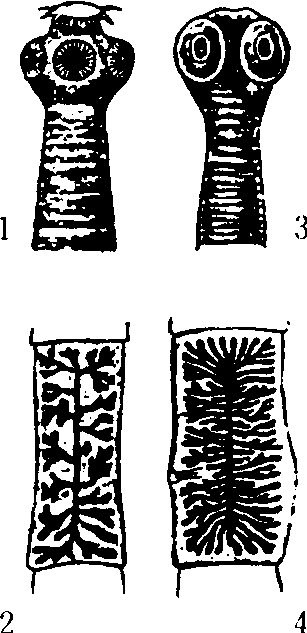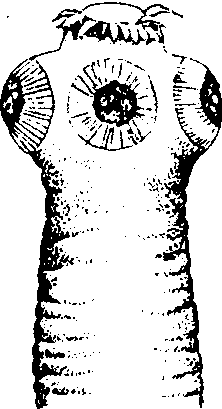猪肉绦虫zhuroutao-chongTaenia solium
无脊椎动物,绦虫纲,带形科。体长较牛肉绦虫短,一般有2~3米,宽7~8毫米,共有节片800~900片,后端的成熟节片长约10毫米。头节圆球形,直径约1毫米,具有4个吸盘,并有顶突和2圈小钩,故又称“有钩绦虫”。人是唯一的终宿主,寄生于小肠内,引起猪肉绦虫病。中间宿主主要是猪,囊尾蚴多寄生在猪的肌肉、肝脏、脑等器官内,为白色小点。生有囊尾蚴的猪肉,俗称“豆猪肉”或“米心肉”。人因吃入未煮熟的、并含有囊尾蚴的猪肉而感染。囊尾蚴也会寄生在人的肌肉、脑、眼等处,引起囊虫病。

图123 绦虫左:猪肉绦虫
1.头部放大 2.妊娠节片
右:牛肉绦虫
3.头部放大 4.妊娠节片
猪肉绦虫
又称“猪带绦虫”、“有钩绦虫”。学名“链状带绦虫”。绦虫纲,带形科。形态上与牛肉绦虫主要不同点为头节球形上具四个吸盘,头端有顶突及两圈小钩。孕节子宫分支不整齐,每侧约7—13支,体节为700—1000节。生活史与牛肉绦虫相似,但中间宿主是猪。囊尾蚴可寄生在人体的皮下、肌肉、脑、眼,引起囊尾蚴病或称囊虫病。人是猪肉绦虫的唯一终宿主。人因吃生的或未煮熟的“米猪肉”(含囊尾蚴的猪肉)而感染,引起猪肉绦虫病。
猪肉绦虫Taenia solium
扁形动物门,绦虫纲,带形科。体长较牛肉绦虫短,一般长2~4米,宽7~8毫米,共有节片700~1000节,节片较薄,略透明。后端的成熟节片较长,约10毫米,卵巢3叶。孕节子宫分枝不整齐,每侧约有7~13枝。头节圆球形,直径约1毫米,具有4个吸盘,并有顶突和2圈小钩(25~50个),故又称“有钩绦虫”。人是唯一的终宿主,寄生于小肠内,引起猪肉绦虫病。常数节同时脱落。中间宿主主要是猪。其幼虫囊尾蚴多寄生在猪的肌肉、肝脏、脑等器官内,为白色小点。有囊尾蚴寄生的猪肉,俗称“豆猪肉”或“米猪肉”。人因吃入未煮熟的、并含有囊尾蚴的猪肉而感染。因囊尾蚴的头节具有小钩,也会寄生在人的皮下组织、肌肉、脑、眼、心、肝、肺、腹膜等处,引起“囊虫病”或“囊尾蚴病”,危害较成虫寄生为大。寄生在眼内时,轻者表现为视力障碍,可见虫体蠕动;重者失明。虫死后,可导致眼球萎缩。特别是寄生在脑内,严重的可使人发作癫痫、头痛、神志不清、视力模糊、偏瘫、失语,甚至突然死亡。

猪肉绦虫
猪肉绦虫
绦虫纲多节亚纲圆叶目带绦虫科的一种。是人畜共患的寄生虫。全世界患病人数(包括囊尾蚴病患者在内)有200万~300万人。早在217年中国医书,《金匮要略》中就有关于“白虫”的记载。610年,巢元方在《诸病源论》中将寸白虫列为“九虫”之一。成虫体长2~4m。前端细为头节,具顶突和大小相同的两圈小钩,25~50个。顶突下有4个吸盘。具雌雄生殖器官,有睾丸150~200个。卵巢分左右2叶,中间有1小叶。子宫分支通常在12支以下。